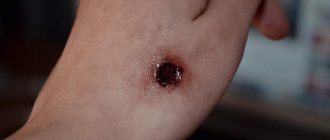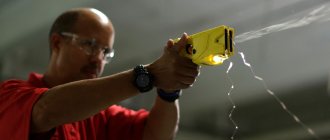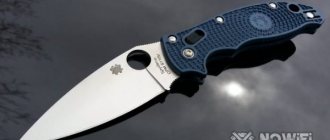Study question No. 7. Basic rules of self-defense. Self-defense means and their use.
Every person has the right to preserve his dignity, honor, health, and life. Human rights guaranteed by the Constitution of the Russian Federation are protected by law. Issues of self-defense and protection of individual rights are regulated in various articles of the Criminal Code of the Russian Federation, for example in Art. 37, "Necessary Defense". According to this article, it is not a crime to cause harm to an attacker in a state of necessary defense, that is, when protecting the personality and rights of the defender or other persons, legally protected interests of society or the state from a socially dangerous attack, unless the limits of necessary defense were exceeded. All persons have the right to necessary defense equally, regardless of their professional or other special training and official position. This right belongs to a person regardless of the possibility of avoiding a socially dangerous attack or seeking help from other persons or authorities.
Deliberate actions that clearly do not correspond to the nature and degree of public danger of the encroachment are recognized as exceeding the limits of necessary defense.
If in the old version the priority was considered to be the protection of “the interests of society and the state,” now the first place is given to “the protection of the individual and rights of the defender.” In other words, if previously a watchman had more rights to shoot at boys stealing apples in a collective farm orchard than to hit a bandit who attacked him on the way home, now it is completely legal to use physical force against someone who is encroaching on health and life.
The law states that the defender is not obliged to turn to anyone for help if he can stop the aggression himself: “... The right (to self-defense) belongs to the person, regardless of the possibility of avoiding attacks or seeking help from other persons or authorities.” At the same time, the defender must balance the degree of threat and response and not allow the limits of necessary defense to be exceeded. The defender can turn into a criminal if he commits deliberate actions that are clearly inconsistent with the nature and danger of the attacks.
That's why you should do everything possible to avoid a fight. If a confrontation is imminent, try to attract witnesses so that they can later confirm that you were defending yourself and not attacking. In a fight, if the enemy is unarmed, use improvised means. If you know martial arts techniques, use them. All cases of self-defense can be divided into two categories:
- if the attack does not pose a direct threat to life or health, then the same principle applies as before - the suitability of the means of defense and attack is assessed;
- if the attack is dangerous, then the law in this case provides the defender with the opportunity to defend himself and cause any harm to the attacker.
Issues of self-defense are also covered in other articles of the Criminal Code of the Russian Federation:
- Art. 38, “Causing harm during the detention of a person who has committed a crime”;
- Art. 39, "Urgent necessity";
- Art. 40, “Physical or mental coercion”;
- Art. 41, “Reasonable risk.”
The basic rules of self-defense include the following:
— Keep your eyes open to everything that is happening nearby at all times and avoid getting into potentially dangerous situations.
- Try to find shelter or help. If possible, run, first assessing the distance and your own physical capabilities.
- Attract the attention of passers-by and those living nearby by shouting: “II fire!” The fear of being on fire prompts people who are usually not inclined to intervene during ordinary cries for help to look out the window and thus become unnecessary witnesses for the criminal.
- When a confrontation with an attacker is inevitable, act with all determination.
- To achieve success, distract the attacker’s attention, perhaps by conceding to him in something, so that you can then unexpectedly quickly and accurately hit him in vulnerable places.
- Act without hesitation, with as much force as possible so that the attacker is unable to respond. If your reaction is weak, it can only anger the bandit even more.
- Use any available item as a weapon of defense (keys, comb, deodorant can, umbrella, a handful of coins, shoes, bag, sand, stones, stick).
The choice of behavior strategy is individual - one thing may help some victims, another may help others. Act according to the circumstances, using your mind and ingenuity as assistants. Physical fitness not only increases the effectiveness of your counteraction, but also reduces fear.
Many common items can be used, if not lethally,
then as a fairly effective weapon.
Sharp objects. Any sharp object, such as a pen or pencil, can be used as a knife and used to stab an opponent. You should aim for the eyes. You can also use a comb for this.
Keys held in your hand with the protruding ends between your fingers can also be used to stab an opponent. A belt with a heavy buckle or a bicycle chain can be used as a whip or riding crop.
Aerosols. Various types of aerosols—sink and oven cleaners, hairspray, deodorants—can be used to blind an attacker. Spray paint is an effective remedy and also leaves marks on the attacker. You can throw bleach in the enemy's eyes. When using the above remedies, do not forget to cover your nose and mouth with your hand and hold your breath.
Canes, umbrellas, police batons. This weapon can hit
the inside of the wrist, elbows and kneecaps of the attacker.
Ordinary items. Almost everything at hand can be used for self-defense. For example, a can or mug can hit the collarbone. The lantern is used as a baton. A light bulb, held by the base and wrapped in clothing or a towel, can cause many cuts if thrown at your opponent's face. Any heavy object—a handful of small coins, a bar of soap, a coffee mug—can be wrapped in a sock or some piece of clothing and used as a club.
Modern legislation gives Russian citizens the right to use means of self-defense from unlawful attacks. It should be remembered that on the territory of the Russian Federation it is prohibited to use brushes, brass knuckles, shurikens, boomerangs and other special objects with shock-crushing and throwing action, gas weapons and canisters filled with nerve agents, poisonous and other substances not permitted by the Ministry of Health of the Russian Federation as weapons for self-defense , as well as gas weapons capable of causing moderate harm to a person located at a distance of more than 1 m.
Portable siren. Not every person has the physical training to effectively counteract the aggression of hooligans, robbers and rapists. In this regard, personal safety experts advise always having personal protective equipment with you. A simple way to protect yourself and your loved ones is the Bodyguard portable siren. This is a device (smaller than a pack of cigarettes) that emits a piercing signal with a power of 130(!) dB, which can be heard at a distance of up to 800 m.
Advantages of the Bodyguard siren:
- even children can be trusted with it. This is not a gas pistol or a spray can, which sometimes does more harm to the owner than to the attacker;
- durable, practically indestructible body. The battery provides a continuous sound signal for up to two hours;
— unlike compressed gas cans, which can be thrown away after one or two uses, “Bodyguard” lasts forever when replacing batteries;
— the device can be attached to a handbag or waist belt. "Bodyguard" can be installed on the front door;
- high effect of psychological influence on the attacker - as a rule, he takes flight;
— the device is activated by pulling out the pin. “The bodyguard emits a deafening signal, even if it is in the hands of an attacker.
Gas weapons. Since July 1977, the Russian Federation Law “On Weapons” came into force. In accordance with it, gas self-defense weapons include pistols, revolvers, mechanical sprayers, aerosol and other devices equipped with tear or irritant substances approved for use by the Ministry of Health of the Russian Federation. Citizens can purchase gas self-defense weapons (with the exception of aerosol devices) under an open license issued by the internal affairs bodies at their place of residence. It is also a permit to store and carry gas pistols. To receive it, you must provide the police department with a written application, a medical certificate of health, a document confirming Russian citizenship, and provide information about the weapon you plan to purchase.
When purchasing self-defense equipment, find out whether the store owner has a license to sell the appropriate special equipment. Having such a license issued by the internal affairs authorities is the most important condition for your safety. Once you are sure that you have a license, do not forget to look at the certificates for the purchased goods. Not all self-defense means, especially imported ones, meet safety requirements. Some of them are prohibited for use in Russia. Therefore, when buying even the simplest aerosol packaging filled with tear-active substances, it is important to read the certificate and instructions for using the special equipment. The full name of the special equipment on the packaging and in the certificate must match.
Gas pistols and revolvers are widely used as means of self-defense. They usually have a caliber of 6, 8, 9 mm and are externally copies of military models: Walter, Colt, Browning, etc. At some distance they are practically indistinguishable from military weapons. On each model of weapon, the number, model name, caliber, and other markings must be stamped in the appropriate places.
Gas pistols and revolvers are not considered firearms. However, there are known cases of death due to their improper or careless use. There are single-shot gas pistols, for example, in the form of a fountain pen. Therefore, in an attack situation, this circumstance should be taken into account, especially if the attacker has any objects in his hands.
A gas revolver or pistol is preferable to many other means of self-defense. When purchasing gas weapons, the following circumstances must be taken into account:
— citizens who have reached the age of 18 and have passed special tests have the right to purchase, store and carry weapons;
- the gun requires maintenance - disassembly, lubrication, etc.;
- the pistol should be carried in a holster or pocket;
— you should not use it in a confined space, for example in an elevator, as you may get hurt from the gas. And the sound effect of a shot reflected from four walls will be perceived as a blow to the head.
The advantages of gas self-defense weapons are the following:
— the appearance and sound effect have a strong psychological impact on the attacker;
- its range of action is slightly greater than that of a gas canister. In order to have time to defend against an attack, gas weapons in dangerous situations should be prepared in advance.
Unlike combat weapons, gas weapons do not guarantee effective impact
on the attackers. Therefore, if the opponents are outnumbered, if they have sticks, knives, etc., it is better to flee. If this is not possible, you should act quickly and decisively. You need to shoot in the neck or lower face area.
At the end of the 80s. In Russia, aerosol cans have become widespread, filled with irritating gaseous substances (irritants), which are ejected in a stream at a distance of up to 150 cm. The aerosol gas with which containers are filled has a tear-producing effect. The use of this self-defense weapon does not involve as many technical difficulties as the use of a gas pistol. However, purchasing, storing and using aerosol cans for self-defense requires certain knowledge, skills and psychological readiness.
Sometimes aerosol cans are labeled "nerve gas." However, this is not true. Toxic nerve agents disrupt the functioning of the nervous system and cause death from paralysis of the respiratory center and heart muscle. The inscription on the package “nerve paralytic” is a common advertising technique. Lethal substances are not used in the arsenal of self-defense means, only irritating gases. This group of substances is usually classified as “police agents.”
Although aerosol cans come in a variety of designs, the contents are the same. The aerosol has a strong irritating effect on the mucous membranes of the eyes and upper respiratory tract, which manifests itself in the form of profuse lacrimation and a painful burning sensation in the nasopharynx. Sometimes the lesion is accompanied by bleeding from the nose, conjunctivitis and redness of the skin. Some types of gas can cause nausea and vomiting. Aerosol preparations should not be used in a confined space - this can lead to serious consequences. When leaving the infected area, irritation of the mucous membranes disappears after 5-15 minutes, the intensity of conjunctivitis begins to decrease after 20-25 minutes, and skin irritation persists for several hours.
The advantages of the aerosol installation are its light weight and dimensions, ease of acquisition (permission from internal affairs authorities is not required), and low cost. Ease of use, high efficiency at distances typical for ordinary conflict situations (1-2 m), and the fact that no special preparation for action is required are also important.
What you should pay attention to when buying a gas canister:
— you should only buy a can that has a certificate confirming the compliance of the special equipment with the regulatory documents in force in Russia;
- The expiration date must be indicated on the packaging. You can purchase those cans that have not expired;
— the spray valve on the package must be sealed. Only in this case can you count on the effectiveness of the special equipment;
— preference should be given to packaging that fits comfortably in the palm of your hand. It is better if the button is protected from accidental pressing by a protective cover.
Firearms. Smoothbore guns are used for hunting and sports. Since 1975 To purchase and store guns, special permission from the internal affairs authorities is required. Hunting rifles are high-power weapons (sighting range up to 80 m). Administrative liability is provided for the illegal acquisition, storage and use of smooth-bore shotguns. For firing a firearm in places not intended for this purpose, administrative liability arises (law enforcement agencies can confiscate the weapon).
If a shotgun is made into a sawn-off shotgun, it takes on the properties of a criminal weapon. Therefore, the manufacture, storage, carrying, acquisition, sale or transfer of sawn-off shotguns to another person entails criminal liability.
The Law of the Russian Federation “On Weapons” provides for the use of weapons by Russian citizens for self-defense within the limits of necessary defense or when absolutely necessary. This law does not contain a list of specific grounds for the use of weapons. Weapons should be used in accordance with the general rules established by the articles of the Criminal Code of Russia on necessary defense and extreme necessity.
When using hunting weapons, you should always remember the proportionality of defensive actions. After all, even the smallest shot fired from a 32-caliber barrel can cause death to a person. For the first few meters, the shot flies in a clump, like a bullet, then it begins to dissipate.
Sometimes attempts are made to weaken the lethal effect of a gun: the cartridge is loaded with coarse salt or homemade rubber bullets are used. These “experiments are extremely dangerous. For example, a rubber bullet can cause the barrel to rupture and injure the gun owner.
It should be remembered that a gun is a source of increased danger. The power of powder gases gives a damaging effect to even harmless objects. There are known cases of serious injury and death when firing a blank cartridge at close range. When fired from a 16-gauge shotgun, a felt wad can pierce a box board. Therefore, the use of firearms is always dangerous and permissible only within the limits of necessary defense.
It is legal to use a hunting rifle to protect the life and health of both the defender and other persons; it is also legal in an attack on a home. The Law on Weapons allows the use of guns to protect property.
Before using a gun, the defender is obliged to warn about his intention and give the attacker the opportunity to stop the criminal actions, for example, commanding the thief: “Hands up, I will shoot!” However, you can't shoot right away; If the attacker fulfills your request, everything will work out without extreme measures.
What if there is no time for warning? In this case, the Police Law removes the requirement to warn and give the offender time. The Weapons Law does not directly address this situation. Therefore, in such cases, one should proceed from the provisions of the law on necessary defense. If the delay of the defender threatens the life or health of people or may lead to other serious consequences, then the owner of the weapon may simply not have enough time to warn.
When using a weapon, you should strive to cause the least harm under the given conditions. To detain a thief, it is enough to easily wound him in the limb. When repelling an armed attack, if there is a real threat to the life of the defender, the offender may suffer serious bodily harm (and even death).
Airguns. In the 18th century air guns and rifles were widespread, not only as hunting weapons, but also as military weapons. For example, the Girardoni rifle of the 1780 model had a caliber of 13 mm, held 30 bullets, and sent a charge 100 m. The modern “pneumatic” is more advanced: its caliber is 4.5 mm, the initial bullet speed is 120 m/s. An air gun fired at close range can cause serious bodily injury. Multi-charged pneumatic (balloon) pistols and revolvers of 6 mm caliber have appeared in Russian gun stores, externally copying combat models and ensuring hitting a target at a distance of 5 m.
However, taking into account the danger of some types of pneumatic weapons, the Law “On Weapons” prohibited the storage or use of pneumatic weapons with a caliber of more than 4.5 mm and with a muzzle energy of more than 7.5 J.
Electroshock devices. The first domestic electric shock devices were made at home and were not always used for self-defense, while in many countries they are legally produced and used primarily to suppress crimes. The so-called timer is used by the police to apprehend criminals. The device, similar to a flashlight, throws out two steel arrows, followed by wires. Touching the body causes a short circuit, and an electrical discharge knocks the criminal down.
The most common electroshock devices are those that operate by direct contact. They can take the form of a baton, an electric razor, etc. When the device is turned on, an electric arc flashes between the electrodes. One 9-volt battery provides 20 minutes of electric baton operation.
With short-term contact (up to 3 s), the attacker can be knocked down; when exposed for 5 s or more, convulsions and irreversible brain changes occur. The high efficiency of electroshock devices has attracted increased attention from both law-abiding citizens and offenders. Many electroshock devices were brought into our country from abroad, but their use was prohibited on the territory of the Russian Federation.
The Law of the Russian Federation “On Weapons” allows the use of electroshock devices and spark gaps of domestic production that have output parameters that meet the requirements of the State Standards of the Russian Federation and the standards developed by the Ministry of Health of the Russian Federation.
Legal weapon for self-defense without a license
The main property of official means of self-defense is the limitation of their destructive effect. Weapons of this type are designed to have a psychological impact on the attacker and cause minimal harm to his health. But when used skillfully, it will help avoid a dangerous situation before it even begins.
Gas canister
An effective and relatively affordable means of protection. It is a small can with the function of spraying a special product. Manufacturers may include chlorobenzalmalonodinitrile (CS) or oleoresin capsicum (OC) in its composition. The action of the first is aimed at irritating the mucous membranes of the respiratory tract and eyes. OC upon contact with skin provokes itching, can cause slight suffocation, and causes coughing. The latter is most effective for self-defense.
What to do if a dog attacks - rules of conduct and methods of protection from the animal
It is important to choose the right gas canister according to the type of spray:
- Aerosol. When the mixture is released, small drops are formed, the direction of which is highly dependent on the wind. Advantages – large affected area. Recommended for use against groups of people, packs of dogs, etc. Range – 1-1.5 m.
- Jet-aerosol. It has a smaller radius of action, but when sprayed, larger droplets are obtained. Characterized by a weak respiratory effect. Effectiveness – up to 2 m.
- Jet. When pressed, a narrowly directed jet is obtained. Recommended for use indoors. Range – up to 3 m.
The cost of a gas canister varies from 350 to 700 rubles. The most popular models are “Pepper 11-A”, “Sword”, “Foam Dragon”.
Stun gun
Hitting the attacker with an electric current using a special device will not cause him irreparable harm, but will disorient him for some time, and the functioning of the central nervous system will be unstable. To achieve this effect, you need to choose the right stun gun for self-defense.
Based on the type of action, they are divided into contact and remote. In the first case, the device comes into contact with the attacker with the active part, in the second, the electrodes are located on a detachable cartridge, which is fired back.
According to current regulations, stun guns are divided into three groups according to voltage and power parameters.
- 70-90 kV and 2-3 W.
- 50-70 kV and 1-2 W.
- 20-50 kV and 0.3-1 W.
Effectively use models belonging to the first group. It must be taken into account that if there is a large amount of clothing, the discharge may not penetrate the attacker’s skin. Also, when using a stun gun, safety rules must be followed.
The average price for popular models varies from 1,600 to 12,000 rubles. For self-defense, they most often purchase “ViperTek”, “Top-Gun”, “Taser”.
Household knife
The use of a household knife as a means of self-defense is extremely undesirable. Handling this type of weapon requires professional skill and practice. There is no need to think that it is a means of preventive defense - the sight of a knife will not always scare away attackers. At the same time, they can be seriously injured, even fatally.
How to choose a traumatic pistol for self-defense - a review of the best options
A knife does not belong to the category of edged weapons if it meets the following basic characteristics:
- the absence of a tip or its placement above the butt line by 5 (10) cm for a blade length of up to 180 mm (from 180 mm);
- if the blade is shorter than 90 mm;
- with a handle less than 70 mm;
- lack of sharpened blade.
This is just a number of characteristics, an extended list of which is given in GOST 51215-98.











